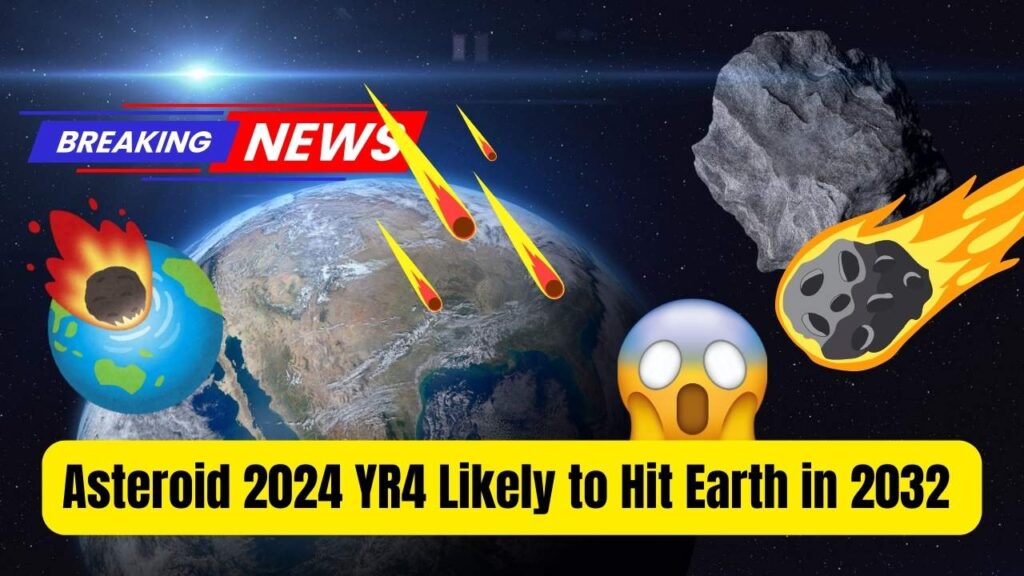Asteroid 2024 YR4 Likely to Hit Earth in 2032: NASA has recently identified asteroid 2024 YR4 as a potential threat to Earth, with a 3.1% chance of impact on December 22, 2032. This asteroid, first discovered in December 2024, has raised concerns due to its unpredictable trajectory and potential damage if it collides with Earth.

Given the increasing discussions on asteroid defense and planetary protection, it’s crucial to understand what asteroid 2024 YR4 is, what NASA and other agencies are doing about it, and what impact—if any—it could have on our planet.
Asteroid 2024 YR4 Likely to Hit Earth in 2032
| Aspect | Details |
|---|---|
| Asteroid Name | 2024 YR4 |
| Discovered | December 2024 |
| Estimated Size | 40-90 meters in diameter |
| Potential Impact Date | December 22, 2032 |
| Impact Probability | 3.1% (as of February 2025) |
| Potential Damage | Up to eight megatons of TNT, equivalent to 500 Hiroshima bombs |
| Risk Zone | Venezuela, Atlantic Ocean, India, parts of Africa |
| Official NASA Update | NASA Official Asteroid Tracking |
Asteroid 2024 YR4 is currently one of the most closely monitored near-Earth objects due to its potential impact risk in 2032. While the probability of impact is relatively low (3.1%), it remains the highest impact risk ever predicted.
NASA and other space agencies are working on tracking, deflection strategies, and emergency preparedness to mitigate any potential threat. As more observations are gathered, the risk may decrease significantly.
For now, the best course of action is to stay informed through official sources like NASA and ESA, and continue supporting planetary defense initiatives.
What Is Asteroid 2024 YR4?
Asteroid 2024 YR4 is classified as a Near-Earth Object (NEO) and belongs to the Apollo group of asteroids, which means it has an orbit that crosses Earth’s path. Its size ranges between 40 to 90 meters, making it similar to the Tunguska event asteroid that exploded over Siberia in 1908.
How Dangerous Is It?
Although a 3.1% probability of impact may seem low, it is one of the highest ever recorded for a near-Earth asteroid. If 2024 YR4 were to impact Earth, it could cause significant destruction, particularly in a populated area.
NASA estimates that the impact energy could be equivalent to eight megatons of TNT, which is about 500 times more powerful than the Hiroshima bomb. The damage could range from localized destruction in a city-sized area to shockwaves and fires affecting a much larger region.
NASA’s Risk Assessment & Tracking Efforts
NASA’s Planetary Defense Coordination Office (PDCO) and the Near-Earth Object Observations Program (NEOO) are actively tracking 2024 YR4 using ground-based telescopes and radar imaging.
Current Monitoring Initiatives
- James Webb Space Telescope: Scheduled to observe the asteroid in March 2025 to refine its trajectory.
- International Asteroid Warning Network (IAWN): Working alongside NASA to determine impact probabilities.
- ESA’s Hera Mission: Although designed for asteroid deflection research, Hera’s data on binary asteroids may be useful in future deflection efforts.
Potential Impact Scenarios of Asteroid 2024 YR4
NASA and other space agencies are considering different scenarios based on where the asteroid might hit:
Scenario 1: Ocean Impact
If 2024 YR4 falls into the ocean, the impact could generate a massive tsunami, endangering coastal cities within thousands of miles.
Scenario 2: Urban Impact
An impact in a densely populated region—such as Mumbai, Lagos, or Bogotá—could result in catastrophic loss of life and infrastructure damage.
Scenario 3: Atmospheric Explosion
Similar to the 2013 Chelyabinsk event, where an asteroid exploded in the atmosphere, 2024 YR4 could detonate before hitting the surface, causing shockwaves and broken windows over a wide area.
How NASA and the World Are Preparing
Governments and space agencies are actively researching ways to deflect or mitigate asteroid threats.
1. Deflection Missions
- DART Mission (2022): Successfully changed the orbit of Dimorphos, proving that asteroid redirection is possible.
- Upcoming Missions: New deflection tests using nuclear devices or kinetic impactors are being planned.
2. Evacuation and Disaster Planning
If impact predictions become more certain, authorities may evacuate areas at risk and implement emergency protocols similar to hurricane or earthquake responses.
3. Role of Private Space Companies
Companies like SpaceX, Blue Origin, and Rocket Lab are also researching asteroid defense strategies. SpaceX’s Starship could play a role in deploying deflection technology.
4. Citizen Science and Public Awareness
Programs like NASA’s Eyes on Asteroids and ESA’s Asteroid Day are encouraging public participation in asteroid tracking and awareness campaigns.
NASA Open Science Internships 2025 – Check Eligibility, Roles & Benefits
Want to Study Computer Science in the US? Here Are the Top 3 Schools and Their Acceptance Rates!
FAQs About Asteroid 2024 YR4 Likely to Hit Earth in 2032
Q1: Should we be worried about asteroid 2024 YR4?
Not yet. The 3.1% impact probability means there is still a 96.9% chance it will miss Earth. However, NASA continues to track it closely.
Q2: Can we stop an asteroid from hitting Earth?
Yes, scientists have proven that asteroid deflection techniques (like the DART mission) can work. Future methods might include nuclear detonations, gravity tractors, or solar sails.
Q3: Has Earth been hit by an asteroid before?
Yes. Some famous asteroid impacts include:
- The Chicxulub asteroid (66 million years ago) that caused the dinosaurs’ extinction.
- The Tunguska event (1908), which flattened 2,000 square kilometers of forest in Siberia.
- The Chelyabinsk meteor (2013), which exploded over Russia and injured 1,500 people.
Q4: Where can I track asteroid 2024 YR4 updates?
You can follow official updates at:
- NASA’s Center for Near Earth Object Studies (CNEOS): https://cneos.jpl.nasa.gov
- ESA’s Near-Earth Object Coordination Centre: https://neo.ssa.esa.int







